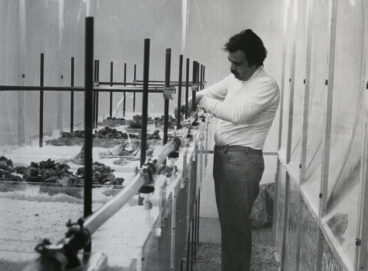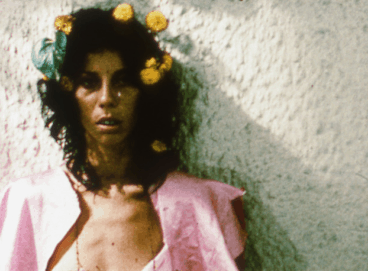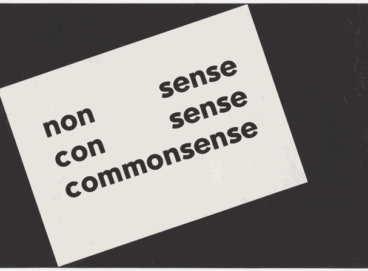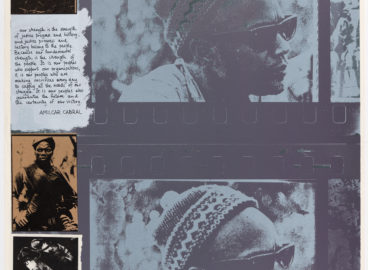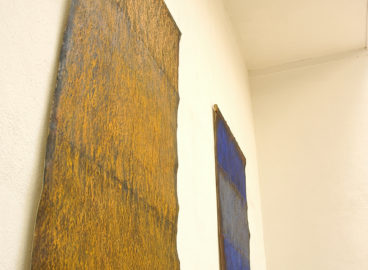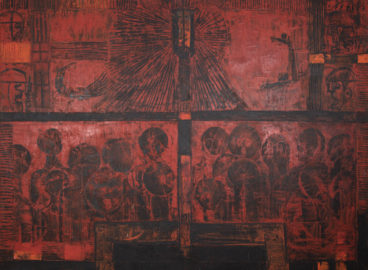This text—a focus on the Mozambican artist Malangatana Valente Ngwenya (1936-2011)—is a shortened version of a presentation made to the C-MAP Africa group in October 2020. It builds on the author’s Ph.D. thesis (2019), as well as on his current research as a postdoctoral fellow. Here, the naming of the period preceding political independence as “anti/colonial” foregrounds the intense struggle between competing forces and serves to introduce the prospect of viewing contemporary subjectivities as mediated products of it.

The question of how to read art produced in Africa during and following colonization continues to be a major challenge for art historians, critics, and theorists. The field of contemporary African art was named in the 1960s, although its roots extend back to the 1920s, and perhaps even earlier.1For the earliest full-length studies, see Evelyn S. Brown, Africa’s Contemporary Art and Artists: A Review of Creative Activities in Painting, Sculpture, Ceramics and Crafts of More Than 300 Artists Working in the Modern industrialized Societies of Some of the Countries of Sub-Saharan Africa (New York: Division of Social Research and Experimentation, Harmon Foundation, Inc., 1966); and Ulli Beier, Contemporary Art in Africa (London: Pall Mall Press; New York: Frederick A. Praeger, 1968). The initial discourse—emerging as it did in the years following independence for most African countries—focused on questions of continuity and change, and on the encounter between tradition and modernity, with tradition frequently signifying ideas of a timeless Africa and modernity being code for Western influence.
Art from Portuguese-speaking Africa has arguably remained peripheral within these broader developments and art historical discussions, although the work of one figure, the Mozambican painter Malangatana Valente Ngwenya (1936–2011), commonly known as Malangatana, stands as an exception. My scholarship on Malangatana seeks to position the artist as a decolonial subject within the national and transnational contexts preceding and following political independence in Mozambique.2Mario De Andrade Pissarra, Locating Malangatana: Decolonisation, Aesthetics and the Roles of an Artist in a Changing Society (Cape Town: University of Cape Town, 2019), https://open.uct.ac.za/handle/11427/31161
To this effect, I have proposed that the naming of the period preceding independence needs to embody the competing forces and balance of power between anti-colonial resistance and colonial rule, and that referring to this historical phase as anti/colonial is one way of articulating this conflict.3Mario De Andrade Pissarra, “Deep Ambivalence: Malangatana’s Anti/Colonial Aesthetic,” in Malangatana: Mozambique Modern, exh. cat. (Chicago: Art Institute of Chicago, forthcoming). Whereas a hyphen indicates a coupling of terms that reinforce one another (e.g., anti-colonial), the slash indicates the option to erase or retain part of the term. In this context, the term “anti/colonial” signifies entanglement and contestation between resistance to colonialism (commonly described as “anticolonial” or “anti-colonial”) and its nemesis: colonial hegemony. In effect, this use of the dash delegates to the reader the authority to describe the period preceding political independence as colonial or anti-colonial, or to recognize this ambivalence as anti/colonial. Either way, the reader is prompted to recognize that the naming of the period is not given and subject to ideological and historical contestation. More recently, I have begun to consider the anti/colonial as not just a historical epoch, but also a form of subjectivity. This has proven to be a highly fecund way to read Malangatana’s early art, particularly because it foregrounds the ambivalence and spirit of provocation that I consider to be critical elements in the artist’s most compelling works.
Reading the anti/colonial in Portuguese-speaking Africa—and in Malangatana’s art in particular—requires an understanding of the specific mode of colonial rule: assimilation. The Portuguese claimed that discrimination was not on the basis of race, but rather of civilization and culture. Indigens could legally acquire the status of assimilated persons (assimilados) with the promise of being accepted as full citizens. Few attained this status given Mozambique’s endemic racism, however, which meant that even assimilados failed to acquire any semblance of equal rights. Nonetheless, the assimilation narrative was a powerful force in forging a third space in which acculturated indigens, along with people of mixed settler and native origins (commonly referred to at the time as mulattos), inhabited a sociopolitical terrain characterized by an ambivalence to both native and settler populations.
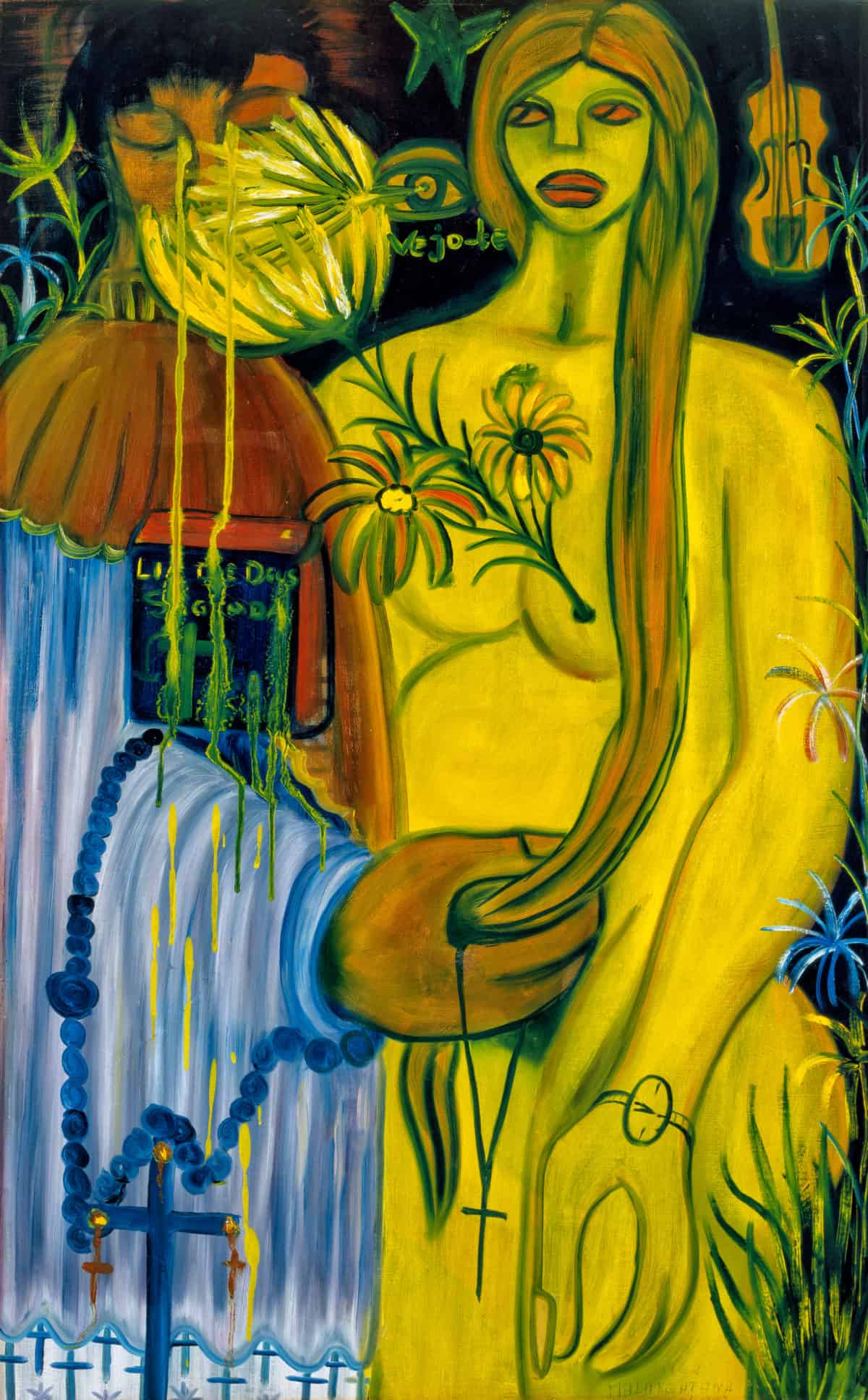
Signs of assimilation are evident in many of the artist’s early works. They are particularly visible in his abundant references to Christianity, which was central to the process of becoming an assimilado. They are also apparent in the obsession with Western notions of feminine beauty. This is most prominent in the light-skinned femme fatale–type figures with long, straight hair. There is a potent convergence of these two streams, of the Christian and the Western, that is manifest in highly provocative, intrinsically ambiguous images—suggesting an ambivalence on the part of the artist, who was neither an aspiring assimilado nor a militant nativist. In fact, traditional African themes or motifs are also often entangled in complex, hybrid, and frequently unsettling scenarios.

These early works, which manifest an anti/colonial subjectivity by way of ambivalence, contrast with works produced (mostly) around the mid-1960s, where a more overt political content suggests an explicitly anti-colonial perspective. These later works, in which the pluralistic diversity of the earlier works has given way to a more generic figuration—and one more autochthonous in appearance—coincide with the artist’s increased politicization. Along with a shift toward what I term a “homogenizing aesthetic,” the earlier assimilationist signs have been increasingly replaced by themes, symbols, metaphors, and allegories that can be interpreted as comparatively literal or even didactic expressions of an anti-colonial position. However, many of these expressly anti-colonial works also reflect an ambivalence. In particular, there is a notable resistance to heroic conventions and to the romanticization of anti-colonial struggle. Instead, there are lucid depictions of suffering, death, and intense conflict, as well as, critically, a lack of differentiation between protagonists. The persistence of ambivalence, even in images ostensibly propagandistic in purpose, provides an extension of the idea of anti/colonial subjectivity as manifesting a deeply unsettled, even traumatic, existential state of being.
It was only in the early 1970s, when the military conflict escalated, that Malangatana began to introduce signs that arguably correspond with an emerging postcolonial consciousness.4I refer to works that reflect a consciousness of a future beyond colonialism. Notably, undulating solar and lunar forms (sometimes evocative of nurturing, maternal breasts) began to appear along the upper perimeter of many of his compositions. Formally, they serve to rupture the shallow pictorial space that is typically claustrophobic in its congestion. Interestingly, the artist persisted in incorporating such composite signs, which I read as emblematic of hope on the distant horizon, throughout the most depraved moments of the civil war.
Malangatana was an artist who wanted to transcend his context and to reach a wider audience, but he was also profoundly influenced by his immediate sociopolitical environment. It is historically apt to consider him as part of a canonical group of pan-African modernists, and to theorize accordingly. But it is equally necessary to consider his specific socialization. Through this dual approach, the character of his early work as the mediated production of an anti/colonial subject becomes evident. It is in considering the interface between colonial and anti-colonial subjectivity that his originality, complexity, and indeed significance comes to the fore. Furthermore, rather than treat him as an argument for exceptionalism, his example introduces the question of whether the concept of anti/colonial subjectivity could prove to be a productive lens through which to view other pioneering African modernists, notably those whose work manifests the dualities and tensions of navigating their encounters with colonialism and nationalism.
- 1For the earliest full-length studies, see Evelyn S. Brown, Africa’s Contemporary Art and Artists: A Review of Creative Activities in Painting, Sculpture, Ceramics and Crafts of More Than 300 Artists Working in the Modern industrialized Societies of Some of the Countries of Sub-Saharan Africa (New York: Division of Social Research and Experimentation, Harmon Foundation, Inc., 1966); and Ulli Beier, Contemporary Art in Africa (London: Pall Mall Press; New York: Frederick A. Praeger, 1968).
- 2Mario De Andrade Pissarra, Locating Malangatana: Decolonisation, Aesthetics and the Roles of an Artist in a Changing Society (Cape Town: University of Cape Town, 2019), https://open.uct.ac.za/handle/11427/31161
- 3Mario De Andrade Pissarra, “Deep Ambivalence: Malangatana’s Anti/Colonial Aesthetic,” in Malangatana: Mozambique Modern, exh. cat. (Chicago: Art Institute of Chicago, forthcoming). Whereas a hyphen indicates a coupling of terms that reinforce one another (e.g., anti-colonial), the slash indicates the option to erase or retain part of the term. In this context, the term “anti/colonial” signifies entanglement and contestation between resistance to colonialism (commonly described as “anticolonial” or “anti-colonial”) and its nemesis: colonial hegemony. In effect, this use of the dash delegates to the reader the authority to describe the period preceding political independence as colonial or anti-colonial, or to recognize this ambivalence as anti/colonial. Either way, the reader is prompted to recognize that the naming of the period is not given and subject to ideological and historical contestation.
- 4I refer to works that reflect a consciousness of a future beyond colonialism.
